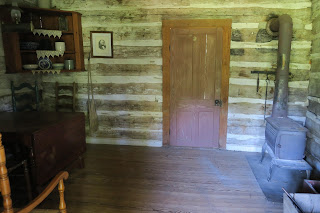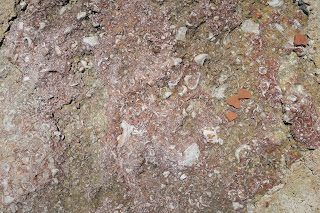A loooooong bridge over Lake Texoma
took us to Oklahoma. A ride through the country brought us to Fort Washita, a National Historic Landmark and Oklahoma Historical Site.
As we perused the Chaplain's Office cum small museum with historical displays, we chatted with the guy on duty for the day. He informed us that Washita (wash ta) is an English pronunciation of two Choctaw words--owa and chito which mean big hunt.
A lot of responsibility
There was no date on this quilt. A 12 year old girl made it with help from a neighbor. I'm guestimating that it is at least 150 years old.
The fort was established in 1842 near the Red River border with the Republic of Texas. Its purpose was to protect the Chickasaw and Choctaw Indians from the Plains Indians in western Indian Territory . It was also the US Indian Agency for the Chickasaw and Choctaw. When tribal lands were allotted to tribal members in the early 1900's, the property was allotted to the Colbert family. The family sold the property to the OK Historical Society in 1962.
Original log house moved to the property it is similar to buildings used for officers' quarters. The oven in front is representative of the era.
This is called a cabin, but since it has a wood floor, it is really a (one room) log house.
Most of the buildings were built of locally quarried limestone. Some were log built on limestone foundations, some were built entirely of limestone. Of all of the original buildings only foundations or other remnants remain.
Fossilized shells are evident on all of the exposed rock.
West barracks on far right, south barracks on left
The Colbert family lived in the west barracks until it was destroyed by fire in 1917.
The south barracks were completely reconstructed in 1972. The barracks burned in 2011, the result of "teen aged boys and alcohol". Efforts are underway to raise money for rebuilding.
Of course we had to see the blacksmith shop. Like the other buildings, nothing remained but the foundation, but
for public education, the shop was reconstructed nearby,It was shuttered and locked.
Our caretaker gladly unlocked it for us. While we walked, he informed us that the gravel path we were using was actually (at the time) the only road through the region. It evolved from a (allegedly) Comanche trail into the Military or Texoma Road. It ran from Fort Smith, AR to Fort Gibson, OK (Muskogee), across the Red River into Texas.
The building also housed a rolling beehive oven and an old carriage which are used during Historical Reenactments held on the grounds.
Officers' swimming pool
Just yanking your chain. This is the commissary basement.
Bachelor officers' quarters with kitchen beyond. Between the drive and the pond are the latrines.
The areas above were left of the Chaplain's Office. The hospital, surgeons quarters and cemetery were on the right. Epitaphs record heart-wrenching sorrow.
To and from the fort we had to travel through this flooded area of dead trees. We learned that last year heavy rains caused a levee to break, letting Lake Texoma into this area. This road ended up 80 feet under water. With no way to drain, the waters will remain until they evaporate.
Our route took us to the city of Madill. From the fort we entered on the north industrialized side.
The courthouse sits in the middle of a square of streets which are lined by businesses. The road to the left of this building took us a block to
the main road where most of the businesses are now.
This is an intersection of 5 roads. The road running between the buildings is the main road in and out of town and the busiest.
Just before we entered the rv park we took a road that ended in a marina and resort across the cove from the rv park. From the local news we learned that this area is still 8 feet above normal pool,
as evidenced by the trees in the water at the yacht marina (above) and the covered marina around the corner.
Hope this wasn't too long or tedious.
Louise and Duane































1 comment:
Awesome fort.
I read the rules for the teachers. Egad...they told them they had to put money back each pay for the lean years. They barely made enough to stay alive during the good years.
Not long or tedious.
Post a Comment